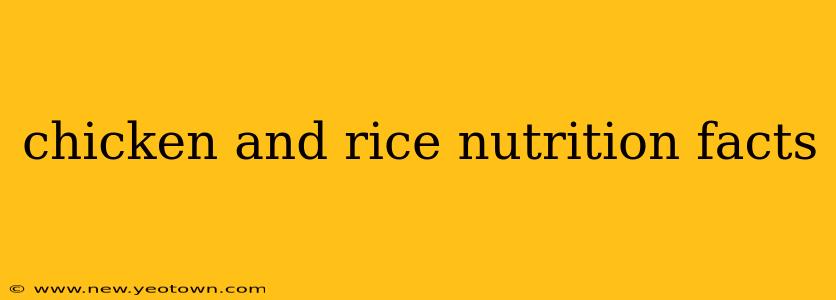Chicken and rice. It's a classic comfort food, a staple in countless cuisines, and a surprisingly versatile dish packed with nutrients. But beyond its deliciousness, what are the real nutritional facts behind this culinary pairing? Let's delve into the details and uncover why chicken and rice deserves a prominent place in a healthy diet.
What are the nutritional benefits of chicken and rice?
This seemingly simple combination offers a wealth of nutritional benefits. Chicken, a lean protein source, provides essential amino acids crucial for building and repairing tissues, boosting metabolism, and supporting immune function. Meanwhile, rice, a carbohydrate powerhouse, offers sustained energy. The specific nutritional profile varies depending on the type of chicken (breast vs. thigh) and rice (brown vs. white), but generally, you're looking at a good source of protein, carbohydrates, and some essential vitamins and minerals.
How many calories are in chicken and rice?
The calorie count of chicken and rice is highly variable. A serving size greatly affects the calorie count, as do the cooking methods and added ingredients. For instance, a simple dish of grilled chicken breast and brown rice will be significantly lower in calories than one made with fried chicken thighs and white rice plus a creamy sauce. A typical serving of grilled chicken breast and brown rice might contain around 300-400 calories, while a richer version could easily exceed 500. To get a precise calorie count for your specific recipe, you'll need to consult a nutrition calculator or app.
Is chicken and rice good for weight loss?
This is a common question, and the answer is nuanced. Chicken and rice can be part of a weight-loss diet, but it depends entirely on portion control and the preparation method. Lean protein like chicken breast keeps you feeling full and satisfied, while complex carbohydrates from brown rice provide sustained energy, preventing energy crashes that might lead to overeating. However, consuming excessive amounts of either, especially with high-calorie additions like butter or creamy sauces, will hinder weight loss efforts.
What are the best types of chicken and rice for a healthy diet?
For optimal health, opt for lean chicken breast and brown rice. Chicken breast is lower in fat and calories than dark meat. Brown rice, compared to white rice, is packed with more fiber, magnesium, and other essential nutrients, promoting better digestion and blood sugar control.
Are there any downsides to eating chicken and rice?
While generally healthy, excessive consumption of white rice can lead to blood sugar spikes. Individuals with certain health conditions, such as diabetes, should be mindful of their portions. Also, the quality of the chicken matters; opting for organic, free-range chicken reduces exposure to antibiotics and hormones. Finally, remember that chicken and rice alone do not constitute a complete and balanced diet. It's crucial to incorporate a variety of fruits, vegetables, and other healthy foods for optimal nutrition.
Can I eat chicken and rice every day?
While chicken and rice offer many health benefits, eating it every day isn't necessarily recommended. Dietary variety is essential for optimal nutrition. A balanced diet includes a wide range of foods providing various vitamins, minerals, and antioxidants. Rotating your meals ensures you receive a broader spectrum of nutrients.
In conclusion, chicken and rice, when prepared thoughtfully, can be a nutritious and delicious component of a healthy diet. By understanding the nutritional facts and making informed choices regarding the types of chicken and rice, cooking methods, and portion sizes, you can harness the benefits of this classic combination while supporting your overall health and well-being.

